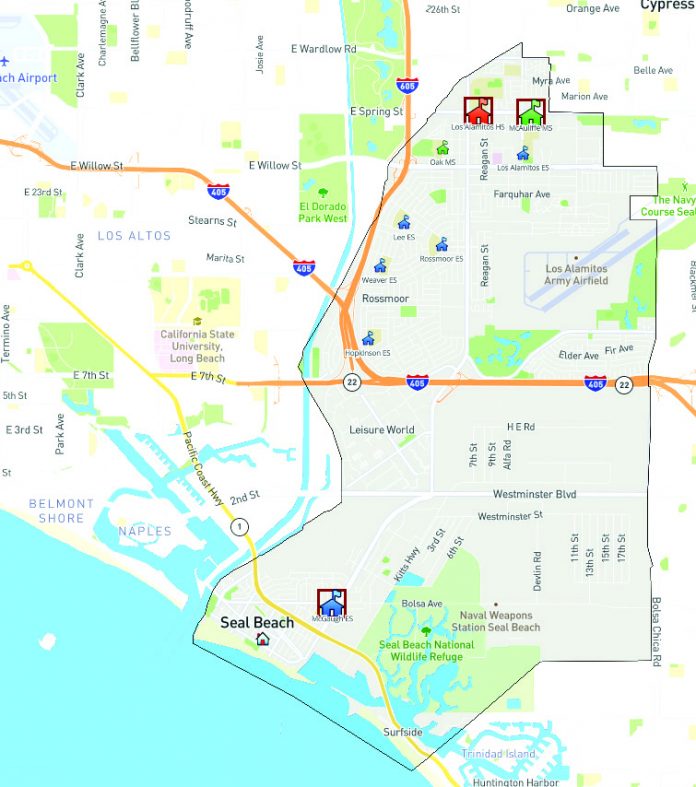
By Jeannette Andruss
There’s a huge shift happening in how voters within the Los Alamitos Unified School District will select their representatives on the Board of Education.
LAUSD is going from an at-large voting system, where voters from across the district pick all five members of the school board, to a trustee-area voting system, where voters select one representative for their area every four years. Trustees must live in the area they represent.
The city of Los Alamitos went through a similar process last year.
It’s in the early stages for LAUSD but the school district is already reaching out to the public for feedback on where to draw the boundaries of the five trustee voting areas.
“The more we hear from the community, the better,” LAUSD Board President Diana Hill said.
LAUSD hired National Demographics Corporation, or NDC, to draw the maps based on census and other data and public input. Two public meetings have already taken place. One on Sept. 18 was attended by around 70 people, and the other on Sept. 24, had only a handful of attendees. A third meeting is scheduled for Oct. 14.
The feedback will be used to create three to four draft maps that should be made public by early November. Two more public meetings will be held after the draft maps are released.
The aim is to have the new map in place by the November 2020 election. That’s when three members from the new voting areas will be elected. Board members Hill and Marlys Davidson were both elected in 2018 and will fill out their four-year terms.
The map will need to be revised in 2021 after the data from the 2020 U.S. Census is released.
Concern about Costly Litigation Behind Change
The district is making the change, in part, to avoid potential litigation. That’s because in the past few years, dozens of cities, including Los Alamitos, and school districts statewide have either been threatened with lawsuits or sued over their at-large election systems.
Douglas Johnson, President of National Demographics Corporation, called it a “quiet tsunami sweeping across the state,” during a presentation at the Sept. 24 public meeting.
Plaintiffs cite violations of the California Voting Rights Act (CVRA), a 2001 law that makes it easier for minority groups to prove at-large voting systems dilute their vote.
Some cities, including Palmdale and Santa Monica, have spent millions of dollars in legal battles and, so far, not one city or school district has prevailed.
LAUSD Superintendent Dr. Andrew Pulver emphasized the district is trying to avoid that fate by making the switch now. “We’re really trying to be proactive to secure our education dollars,” he said at the Sept. 18 meeting.
How will maps be drawn?
Los Alamitos Unified School District has nine schools, around 10,000 students and covers an area populated with approximately 48,000 people. It encompasses Los Alamitos, Seal Beach, Rossmoor and small slivers of Cypress and Long Beach.
The goal will be to make the trustee areas responsive to communities of interest, contiguous, and equal in population. Each trustee area will consist of roughly 9,600 residents.
There are three questions demographers want residents to consider in this process. First, what is your neighborhood or community of interest? Second, do you want your neighborhood to be in one trustee area or have multiple representatives? And lastly, what are other communities of interest that should be considered?
For example, the city of Seal Beach has only one LAUSD school within its boundary, J.H. McGaugh Elementary school. Would community members prefer having one board member as their sole representative? Or would having more than one trustee area in the city give residents more representation on the board and connect them to other schools?
“There’s no right answer,” Johnson said. “It’s all choices and trade-offs.”
In addition to public input, school attendance areas, natural dividing lines, such as the 405 Freeway, and shared demographic characteristics are some factors that will influence the drawing of the maps.
While race cannot be the dominant factor in determining the map, it will be considered as the intent of the CVRA is to prevent racially polarized voting.
In LAUSD, Latinos make up 13% of eligible voters and Asians make up 11%, according to a report presented at the Sept. 18 meeting. The report noted African-Americans and Native Americans “do not have geographic concentrations large enough to significantly swing the demographics of a trustee area.”
Residents at both public meetings questioned how Leisure World would factor into the new trustee areas. The private retirement community in Seal Beach does not allow school-age children to live there but because of the size of its population, it could easily cover an entire trustee area on its own.
No matter how the district is divided up, Dr. Pulver said he thinks board members will “still have a stake and a heart and an interest” in all LAUSD students
Board President Diana Hill agrees. “I really believe as a school board our job is to represent all students,” she said.
What’s next?
The next public meeting is Oct. 14 at 6:30pm at the District Office Boardroom. After the draft maps are released they will be discussed at two public meetings, one on Nov. 12 at 6:30pm and another on Dec. 10 at 6:30pm at the same location.
If you can’t attend a meeting, you can give input by emailing trusteeareaelection@losal.org. For more information, visit losal.org/voting.
